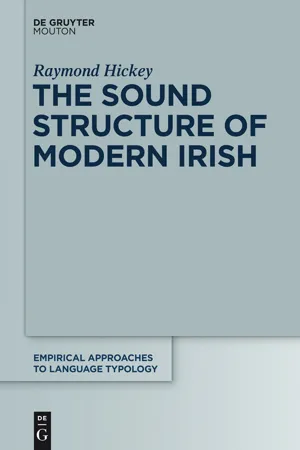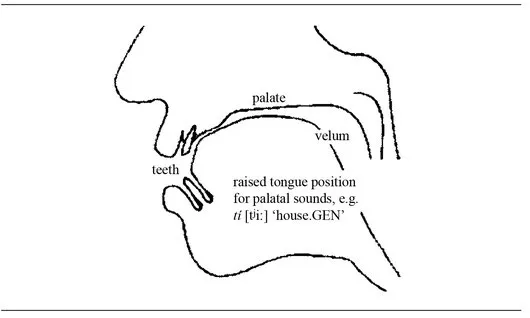1. Sound inventory
Irish is an Indo-European language and its affiliation is clear from most of its core vocabulary which it shares with other members of this family. However, during its development from an early form of Celtic on the European mainland (in the last millennium BCE), the language changed its grammatical type, shifting its canonical word order to VSO and establishing post-specification as the norm (Hickey 2002). The phonology of the Celtic languages also underwent major changes, notably lenition (Honeybone 2008, Jaskula 2008, Kirchner 2008; Scheer and de Lacy 2008) at the beginnings of words. This was in origin a sandhi phenomenon (Andersen 1986) but later gained systemic status in all the Celtic languages (Ternes 1990: 12-15). In the Q-Celtic sub-branch of Insular Celtic a further significant development took place. Here palatalisation arose as a secondary articulation (Ternes 2010) with velar and coronal consonants in the environment of high vowels and later it spread to encompass labials as well (Jackson 1967b). In the course of time this palatalisation achieved systemic status through reanalysis by first language learners (Hickey 2003b) yielding the twin sets of changes (i) palatalisation / de-palatalisation and (ii) initial mutations. These are used to distinguish the majority of grammatical categories in the Q-Celtic languages, i.e. Irish, Scottish Gaelic and Manx (the latter two deriving historically from Irish).
The development of systemic palatalisation is something which Irish shares with Slavic (Stolz and Levkovych 2015), especially the East Slavic languages, above all Russian (Zubritskaya 1995). The main similarity with Russian is the existence of palatal and non-palatal pairs across the entire inventory of consonants (Hickey 2011a: 234-238), see section III.5 for further discussion).
Apart from the classification according to whether consonants are palatal or non-palatal (see Table 1), Irish also has a voice distinction with voiced and voiceless consonants at most common points of articulation. There are labial, labio-dental, dental/alveolar and velar pairs of segments, distinguished by voice, along with the single voiceless glottal fricative, /h/. Irish is notable, however, in not having voiced sibilants and in this respect aligns itself, for instance, with the Scandinavian languages, i.e. North Germanic (Danish, Norwegian, Swedish, Faroese, Icelandic) and Finnish. Neither does it have affricates, if one ignores one or two cases of sandhi affrication and the situation in Northern Irish and a few other points in the Irish-speaking areas which show affrication on the release of coronal palatal stops. Consonants do not have distinctive length, although this was the case in the history of the language before the Middle Irish period (900-1200) when long consonants existed word-internally and when geminates were treated differently from non-geminates in Latin loanwords (Thurneysen 1946: 85-93). The effects of long sonorants on the vowels preceding them can still be seen today. The reflexes of these sonorants are an important defining criterion for the different dialects of modern Irish (see section I.2.3 above).
Table 1. Consonants of Modern Irish
The systemic distinction between long and short vowels has been maintained throughout the history of Irish. In the realisation of sound contrasts the short vowels are significant in that their quality is affected by the palatal or non-palatal quality of segments which may follow them in a syllable coda (see discussion in II.1.9.2 and II.1.9.3 below).
1.1. The palatal / non-palatal distinction
In Modern Irish this distinction applies to all consonants, with the exception of /h/, and is an essential element of both the grammar and lexical structure of the language. Phonetically, palatal consonants are produced by raising the middle of the tongue towards the palate. This provides the constriction which is the acoustic cue for such segments. Palatal sounds are indicated in transcription by placing a superscript yod [j] after the sound in question, e.g. teach /tjax/ ‘house’. The realisation of palatal sounds, especially of coronals, varies greatly across the dialects: Northern [tʃæx], Western [tjæx], Southern [tjæx] (see section I.2.3 above). Non-palatal consonants are generally velarised with the middle of the tongue lowered and the back raised towards the velum. Acoustically, this gives a hollow sound to non-palatal segments which indicates that they are the opposite of palatal sounds with the constriction just described.
Figure 1. Articulation of palatal sounds, typical of Western Irish (just before dorso-palatal contact)
This ‘hollow’ quality is most noticeable with non-palatal versions of the sonorants
l and
n. e.g.
lá /lɣɑ:/ [łɑ:] ‘day’,
ná /nɣɑ:/
‘nor’. Perhaps for this reason, these sonorants show a three-way distinction in Western and Northern Irish, i.e. /l
ɣ – l – l
j/ and /n
ɣ – n – n
j/ (see section II.1.8 for further details and discussion). According to IPA practice, non-palatal sounds are indicated in transcr...



